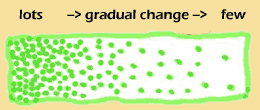Watching diffusion happen
Fundamentally,the word ‘gradient’ in this context, is taken to mean the change in the concentration of particles over two points.
Consider the diagram below, where the number of particles changes from ‘lots’ to ‘few’.

Now imagine all these particles bouncing around. In fact, small particles like atoms are in constant motion and this is what causes diffusion. How? Well, at the left, where there are lots of particles, none of them will travel very far without bumping into another particle. So, they will keep bouncing around, back and forth, up and down, and not get very far. On the other hand, on the right, where are few particles, they can move a long distance without any bounces. In particular, once a particle is heading for an empty area, it keeps going -- there's nothing there to stop its progress.
More succinctly, we say that:
- When the concentration is high,
mean displacement (average distance moved) is small. - When the concentration is low,
mean displacement is high
The applet below will help you visualise diffusion. Before you start the applet you should realise that the particles in the box are not distributed randomly and not spread out evenly. Instead, they are clustered at the centre of the box. We say there is a steep gradient between the centre and the sides of the box. Now start the simulation. Notice that although each particle is moving randomly, the net effect is that the clumped particles get spread out evenly. In other words, there is a flux of particles from the centre to the edges at least until the particles are spread out evenly. After that, there is no net movement - no flux.
Applet courtesy of N. Betancourt
You can also click off the trace function so that you can watch the particles moving about randomly.
If you run the simulation several times with different numbers of particles, then you will see that the particles always move from a state of high order (all particles in the centre of the screen) to a state of disorder (all particles distributed rather evenly throughout the screen).
You can also see that diffusion only occurs when there is a gradient. After the gradient is gone, then the continual movement no longer results in a net change in distribution. In other words, without a gradient there is no flux.
(If you don't see the applet, you can download java at http://java.com/en/download/index.jsp. )
Copyright University of Maryland, 2007
You may link to this site for educational purposes.
Please do not copy without permission
requests/questions/feedback email: mathbench@umd.edu